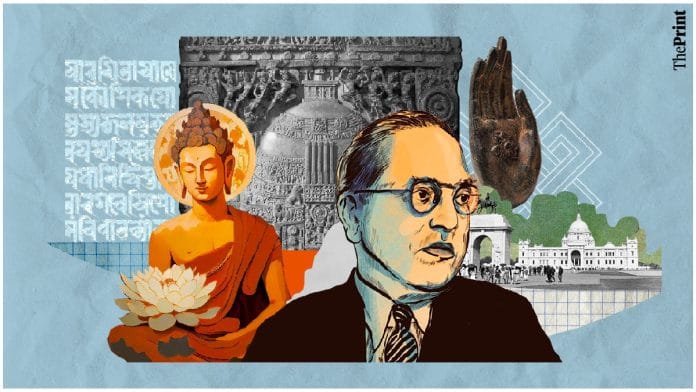Thank you dear subscribers, we are overwhelmed with your response.
Your Turn is a unique section from ThePrint featuring points of view from its subscribers. If you are a subscriber, have a point of view, please send it to us. If not, do subscribe here: https://theprint.in/subscribe/
Buddhism serves as a natural cultural bridge between India and ASEAN nations, yet this spiritual connection faces significant challenges rooted in India’s internal development disparities. While Buddhism originated in Bihar with Buddha’s enlightenment in Bodh Gaya, the state’s current underdevelopment creates a perception problem that undermines India’s soft power projection in the region.
ASEAN countries maintain substantial Buddhist populations – Thailand (90%), Cambodia (95%), Myanmar (88%), and Laos (65%) – creating natural affinities with India’s Buddhist heritage sites. However, this religious connection has not translated into proportional economic and political cooperation, partly due to perceptions of India’s developmental challenges, particularly in Bihar. The contrast becomes even more stark when considering that ancient Buddhist universities in Bihar, particularly Nalanda and Vikramshila, once attracted scholars from across Asia, establishing intellectual networks that transcended political boundaries.
The Development-Politics Paradox
Bihar presents one of India’s most striking federal paradoxes that extends far beyond regional politics into national and international implications. The state consistently ranks among the lowest in development indicators – 35th out of 36 states in per capita income, literacy rates, and Human Development Index – while maintaining outsized political influence through its 40 Lok Sabha seats. This creates what can be termed the “Bihar Development Paradox” where political significance inversely correlates with development metrics.
Despite increased government spending on education and healthcare, Bihar faces significant challenges in quality delivery, particularly for marginalized communities. The gap between policy implementation and actual outcomes remains wide, reflecting broader governance challenges. Yet paradoxically, Bihar’s political significance in Indian national politics remains substantial, making it crucial for electoral outcomes. This inverse relationship between state development and political influence demonstrates a troubling pattern where states like Bihar and Uttar Pradesh, despite ranking poorly in development metrics, wield disproportionate political influence due to their large populations and corresponding electoral representation.
Bihar’s political landscape is significantly influenced by caste-based mobilization, with upper castes maintaining electoral dominance despite constituting only 14% of the population. This over-representation reflects how traditional social structures maintain political relevance even amid democratic reforms and economic modernization. The result is a political system that may inadvertently reward underdevelopment through increased attention and resources directed toward backward regions, creating a cycle where electoral success doesn’t necessarily correlate with developmental progress.
Global Implications and Missed Opportunities
The Bihar image problem extends far beyond India’s borders, creating significant perception challenges for the country’s global leadership aspirations. When ASEAN countries or other developing nations assess India’s development model, the prominence of states like Bihar in Indian politics may undermine confidence in India’s capabilities. This perception challenge becomes particularly acute in relationships with countries that prioritize infrastructure development and economic growth, where China’s emphasis on infrastructure development and economic modernization contrasts sharply with India’s more complex development profile.
Meanwhile, India possesses underutilized assets in the form of its diaspora in Indian Ocean islands. The Indian diaspora represents a significant concentration of overseas Indian communities, with Mauritius hosting approximately 70% population of Indian origin. These communities maintain strong cultural connections to India, with Hinduism dominating in Mauritius and Indian cultural practices remaining influential across Seychelles, Madagascar, and Comoros. Members of the Indian diaspora have achieved significant political positions in various Indian Ocean island nations, providing India with potential diplomatic advantages.
However, infrastructure challenges, including limited air and sea connectivity, constrain the full potential of these relationships. The absence of direct transportation links limits travel, trade, and cultural exchange, reducing the diaspora’s effectiveness as a bridge for India’s engagement with the region. This represents a missed opportunity for India to leverage its cultural connections for enhanced diplomatic engagement.
India has positioned itself as a leader in the Global South through initiatives like hosting the Voice of the Global South Summit and promoting South-South cooperation. The country’s role in BRICS and space diplomacy reflects its aspirations to represent developing nations’ interests. However, India’s Global South leadership faces substantial contradictions. The country’s simultaneous alignment with the United States through Indo-Pacific strategies while claiming Global South leadership creates credibility issues. Additionally, India’s exclusion of key developing nations like China, Pakistan, and Brazil from its Global South diplomacy reflects strategic limitations.
The Way Forward
The path forward requires India to develop more coherent strategies that address internal development disparities while leveraging cultural and historical connections for international engagement. This may involve targeted development programs for states like Bihar, enhanced connectivity with diaspora communities, and more effective integration of domestic development success with international diplomatic initiatives.
The Buddhist connection with ASEAN countries offers opportunities for enhanced cooperation, while the diaspora in Indian Ocean islands represents an underutilized asset for diplomatic engagement. However, realizing these opportunities requires addressing the perception challenges created by uneven development and political dynamics. Ultimately, reconciling internal diversity and contradictions with external leadership ambitions represents India’s fundamental challenge in 21st-century global governance and South-South cooperation. The resolution of this challenge will significantly impact India’s ability to serve as an effective leader in the Global South while maintaining its cultural and spiritual connections with Southeast Asia.
These pieces are being published as they have been received – they have not been edited/fact-checked by ThePrint.


